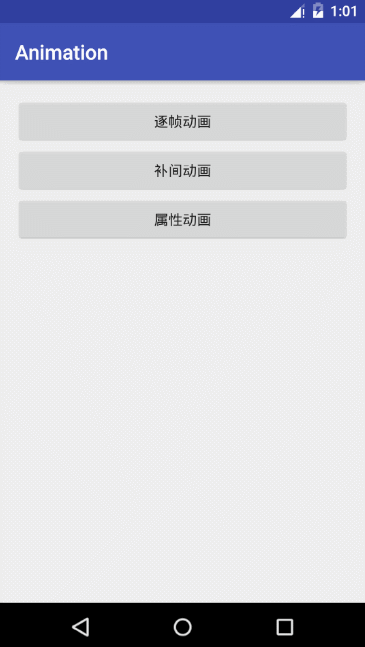逐帧动画
逐帧动画也叫 Drawable Animation,是最简单最直观的动画效果。
在Android 中实现逐帧动画就是由设计师给出一系列状态不断变化的图片,开发者就指定这些图片显示的持续时间,然后顺序开始播放这些图片,就形成了动画了。
使用逐帧动画 既可以使用XML的方法实现,也可以使用代码来实现。
XML
首先把资源文件(每一帧的图片)放在 res/drawable 下。 如图:
然后在这里 新建一个XML文件。 在这个文件中使用的
frme_animation.xml
android:oneshot 来控制动画是否循环播放, false 表示 循环播放 , true 表示 不循环播放 。
在控件的布局中给控件使用这个 drawable 文件
定义好了这个动画,为了让动画播放,就要使用代码让他开始播放,代码如下:
//xml
ImageView ivFrameXml = (ImageView) findViewById(R.id.iv_frame_xml);
AnimationDrawable background = (AnimationDrawable)ivFrameXml.getDrawable();
background.start();
代码方式
代码的方式更加简单,新建一个 AnimationDrawable ,并为他增加每一帧的图片和持续时间就可以了。
//code
ImageView ivFrameCode = (ImageView) findViewById(R.id.iv_frame_code);
AnimationDrawable animationDrawable = new AnimationDrawable();
for (int i = 1; i <= 5; i++) {
int id = getResources().getIdentifier("z_1_die_0" + i, "drawable", getPackageName());
Drawable drawable = getResources().getDrawable(id);
animationDrawable.addFrame(drawable,300);
}
ivFrameCode.setImageDrawable(animationDrawable);
//循环播放
animationDrawable.setOneShot(false);
//开始播放
animationDrawable.start();
效果如图所示:
补间动画
补间动画无须再知道动画过程中的每一帧了,只需要定义动画的开始和结束,并且指定变化的时间和方式就可以了,他会自动补全中间的过程。Android会通过所给出的开始值与结束值,再根据中间变化的规律,最后计算出每一帧图片显示的效果,最后直接显示出来。
主要包括这四种基本效果:透明度变化 Alpha 、缩放变化 Scale 、 位移变化 Translate 、旋转变化 Rotate 。这四种效果可以动态组合,从而实现复杂的动画。
插值器 Interpolator
补间动画能够自己补充中间的内容,其实靠的就是这个。
Interpolator 会根据类型不同,选择不同的算法计算出补间动画所需要动态插入的密度和位置,Interpolator 负责控制动画的变化速度,他可以 匀速、加速、减速、抛物线等多种变化。
public interface Interpolator extends TimeInterpolator {
// A new interface, TimeInterpolator, was introduced for the new android.animation
// package. This older Interpolator interface extends TimeInterpolator so that users of
// the new Animator-based animations can use either the old Interpolator implementations or
// new classes that implement TimeInterpolator directly.
}
public interface TimeInterpolator {
/**
* Maps a value representing the elapsed fraction of an animation to a value that represents
* the interpolated fraction. This interpolated value is then multiplied by the change in
* value of an animation to derive the animated value at the current elapsed animation time.
*
* @param input A value between 0 and 1.0 indicating our current point
* in the animation where 0 represents the start and 1.0 represents
* the end
* @return The interpolation value. This value can be more than 1.0 for
* interpolators which overshoot their targets, or less than 0 for
* interpolators that undershoot their targets.
*/
float getInterpolation(float input);
}
由上面的代码可以清楚的看到一点,Interpolator 只是继承于 TimeInterpolator ,里面只是一个空实现而已。而在 TimeInterpolator 下,也只有 float getInterpolation(float input); 一个方法。input 是一个 0.0 ~ 1.0 的值 , 经过自定义的方法 ,那么只要返回适当的值,那么就能实现各种的效果。
例如下面是系统实现的先加速后减速的Interpolator。
AccelerateDecelerateInterpolator
public float getInterpolation(float input) {
return (float)(Math.cos((input + 1) * Math.PI) / 2.0f) + 0.5f;
}
当然Android SDK 中已经实现了几个 Interpolator 让开发者直接使用。
下面继续介绍动画,补间动画和逐帧动画一样,既能使用XML实现也能使用Code实现。
XML的文件应放置在 res/anim 目录上。
透明度变化 Alpha
XML
anim_tween_alpha.xml
android:interpolator 用来指定插值器
android:repeatMode 重复的模式
android:repeatCount="-1" 重复的次数。 -1 为无限循环。
XML写完了,就要在代码中使用他了。
ImageView ivTweenXml = (ImageView) findViewById(R.id.iv_tween_xml);
AnimationSet alphaSet = (AnimationSet) AnimationUtils.loadAnimation(TweenActivity.this,R.anim.anim_tween_alpha);
ivTweenXml.startAnimation(alphaSet);
Code
ImageView ivTweenCode = (ImageView) findViewById(R.id.iv_tween_code);
AlphaAnimation alphaAnimation = new AlphaAnimation(0, 1);
alphaAnimation.setDuration(1000);
alphaAnimation.setRepeatMode(Animation.REVERSE);
alphaAnimation.setRepeatCount(-1);
ivTweenCode.startAnimation(alphaAnimation);
上面都实现了透明度从0到1.
缩放变化 Scale
XML
anim_tween_scale.xml
ImageView ivScaleXml = (ImageView) findViewById(R.id.iv_scale_xml);
AnimationSet scaleSet = (AnimationSet) AnimationUtils.loadAnimation(TweenActivity.this,R.anim.anim_tween_scale);
ivScaleXml.startAnimation(scaleSet);
pivotX 中心点
直接写数字代表 控件本身的坐标系中的x的值
数字后面加了 % 例如 :50% ,代表 在本身的坐标系中的 x轴长度的50%
Code
ImageView ivScaleCode = (ImageView) findViewById(R.id.iv_scale_code);
ScaleAnimation scaleAnimation = new ScaleAnimation(0.2f, 1, 0.2f, 1f, Animation.RELATIVE_TO_SELF, 0.5f, Animation.RELATIVE_TO_SELF, 0.5f);
scaleAnimation.setDuration(1000);
scaleAnimation.setRepeatMode(Animation.REVERSE);
scaleAnimation.setRepeatCount(-1);
ivScaleCode.startAnimation(scaleAnimation);
位移变化 Translate
XML
anim_tween_translate.xml
ImageView ivTranslateXml = (ImageView) findViewById(R.id.iv_translate_xml);
AnimationSet translateSet = (AnimationSet) AnimationUtils.loadAnimation(TweenActivity.this,R.anim.anim_tween_translate);
ivTranslateXml.startAnimation(translateSet);
Code
ImageView ivTranslateCode = (ImageView) findViewById(R.id.iv_translate_code);
TranslateAnimation translateAnimation = new TranslateAnimation( 0,100,0,0);
translateAnimation.setDuration(1000);
translateAnimation.setRepeatMode(Animation.REVERSE);
translateAnimation.setRepeatCount(-1);
ivTranslateCode.startAnimation(translateAnimation);
旋转变化 Rotate
XML
anim_tween_rotate.xml
ImageView ivRotateXml = (ImageView) findViewById(R.id.iv_rotate_xml);
AnimationSet rotateSet = (AnimationSet) AnimationUtils.loadAnimati(TweenActivity.this,R.anim.anim_tween_rotate);
ivRotateXml.startAnimation(rotateSet);
Code
ImageView ivRotateCode = (ImageView) findViewById(R.id.iv_rotate_code);
RotateAnimation rotateAnimation = new RotateAnimation( 0,360, Animation.RELATIVE_TO_SELF, 0.5f, Animation.RELATIVE_TO_SELF, 0.5f);
rotateAnimation.setDuration(1000);
rotateAnimation.setRepeatMode(Animation.REVERSE);
rotateAnimation.setRepeatCount(-1);
ivRotateCode.startAnimation(rotateAnimation);
组合起来
上面显示的就是每一种效果各自实现的方法,现在我们可以让这些效果组合起来。
xml
ImageView ivTogetherXml = (ImageView) findViewById(R.id.iv_together_xml);
AnimationSet togetherSet = (AnimationSet) AnimationUtils.loadAnimation(TweenActivity.this,R.anim.anim_tween_together);
ivTogetherXml.startAnimation(togetherSet);
Code
ImageView ivTogetherCode = (ImageView) findViewById(R.id.iv_together_code);
AnimationSet animationSet = new AnimationSet(false);
animationSet.addAnimation(alphaAnimation);
animationSet.addAnimation(rotateAnimation);
animationSet.addAnimation(translateAnimation);
animationSet.addAnimation(scaleAnimation);
ivTogetherCode.startAnimation(animationSet);
效果如图所示:
监听
播放动画效果的时候我们可以做到对动画开始、结束、重复的监听。
alphaAnimation.setAnimationListener(new Animation.AnimationListener() {
@Override
public void onAnimationStart(Animation animation) {
//动画开始时调用
}
@Override
public void onAnimationEnd(Animation animation) {
//动画结束时调用
}
@Override
public void onAnimationRepeat(Animation animation) {
//动画重复时调用
}
});
只要在对应的位置添加自己想要的效果,那么就可以实现了。
AccelerateInterpolator 加速,开始时慢中间加速
几种自带的动画插入器
DecelerateInterpolator 减速,开始时快然后减速
AccelerateDecelerateInterolator 先加速后减速,开始结束时慢,中间加速
AnticipateInterpolator 反向,先向相反方向改变一段再加速播放
AnticipateOvershootInterpolator 反向加超越,先向相反方向改变,再加速播放,会超出目的值然后缓慢移动至目的值
BounceInterpolator 跳跃,快到目的值时值会跳跃,如目的值100,后面的值可能依次为85,77,70,80,90,100
CycleIinterpolator 循环,动画循环一定次数,值的改变为一正弦函数:Math.sin(2* mCycles* Math.PI* input)
LinearInterpolator 线性,线性均匀改变
OvershootInterpolator超越,最后超出目的值然后缓慢改变到目的值


